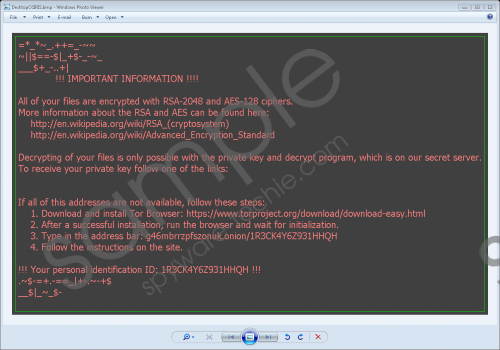Do you know what Osiris Ransomware is?
Osiris Ransomware is not an entirely new threat, but more like a new version of another malicious program known as Locky Ransomware. These infections are quite identical in many ways, although there are some differences too, we will discuss more this new version further in the article. The bad news is that the ransom for the decryptor of this malware’s encrypted data is expensive. Apparently, the malicious program's creators could ask you to pay 2 Bitcoins, which is a little bit more than 1500 US dollars at the moment of writing. Under such circumstances, we would advise you not to risk your savings and better eliminate the threat while using a legitimate antimalware tool or try to erase it manually by following our removal guide placed below.
Same as its previous version, Osiris Ransomware should reach its victims through suspicious email attachments. Malicious files sent by email are often deliberately made to look harmless and curious. For instance, the infected files may look like text documents, images, invoices, and so on. Therefore, users can infect the system accidentally if they are not careful enough. If you do not have antimalware software to guard the system against threats, you should always be extra careful with suspicious data, for example, you could avoid opening it, or try to find more details, like who sent it or why it was sent to you, and so on.
As long as you do not open the infected file, the malware cannot do anything to the computer. However, if you launch Osiris Ransomware’s installer, the application could enter the system without your permission and most likely without your knowledge too. By the time users realize what has happened the threat might already be finished with the encryption process. In any case, the malware should announce its appearance on the system as soon as it locks all targeted data. It should do so by replacing user’s Desktop wallpaper with a picture called DesktopOSIRIS.bmp. Osiris Ransomware screenshot
Osiris Ransomware screenshot
Scroll down for full removal instructions
The image (DesktopOSIRIS.bmp) contains the so-called ransom note that explains what the malicious application did to user’s data and instructs how to purchase the decryptor. To get the user’s attention, the message starts with “!!! IMPORTANT INFORMATION !!! All of your files are encrypted with RSA-2048 and AES-128 ciphers.” The mentioned cryptosystems are strong, and as the message continues to explain, you have to have the decryption key to unlock your data. Further in the message, Osiris Ransomware’s creators display a link to redirect the user to a website with payment instructions.
The website the ransom note redirects you to offers to purchase Locky Decryptor. As we mentioned before Osiris Ransomware is a new version of Locky Ransomware, so it is possible that the same decryptor could work for this recently created version. Unfortunately, the asked sum is not a small one as the malicious program’s creators demand 2 Bitcoins. Paying the ransom is usually risky and in this case you could lose quite a lot of money since there are no reassurances you will receive the decryptor. Naturally, we advise users not to take any chances and remove the threat as soon as possible.
The malicious program could be erased manually, but if you want to be entirely sure it is completely deleted you ought to use an antimalware tool instead. Users who do not have a reliable security tool could install our recommended software or another reputable tool of their choice. Then set it to perform a full system scan and wait till it detects the malware and other possible threats. After the scan is over, you should click the removal button, and all detections would be deleted automatically. Nonetheless, if you prefer to deal with Osiris Ransomware manually, you may try to get rid of it by following the instructions placed below and only then scan the system with an antimalware tool if you feel it could be beneficial for the system.
Eliminate Osiris Ransomware
- Press Windows Key+E.
- Use the Explorer to locate such directories as Downloads, Temporary Files, Desktop, and other folders where you may have saved the malicious file.
- Find the malicious file that you launched before the system got infected.
- Select the file, press Shift+Delete and click OK to erase it permanently.
- Go to %USERPROFILE%\{username}, find an image called DesktopOSIRIS.bmp.
- Click the image, press Shift+Delete and select OK to remove it.
- Close the Explorer.
In non-techie terms:
Osiris Ransomware is a malicious threat that locks user’s documents and other data on the computer and does not allow him to access it. Afterward, the malware displays a message from its creators who demand their victims to pay a ransom if they want to get the decryptor. In other words, it is a tool used to extort money from users who accidentally infect their systems. If you encountered this infection as well, we would advise you not to risk paying the ransom as the sum is rather huge. Instead, we encourage users to recover data from copies if they have any, but firstly it would be safer to delete the malware either manually with the removal guide located above or with a security tool.
